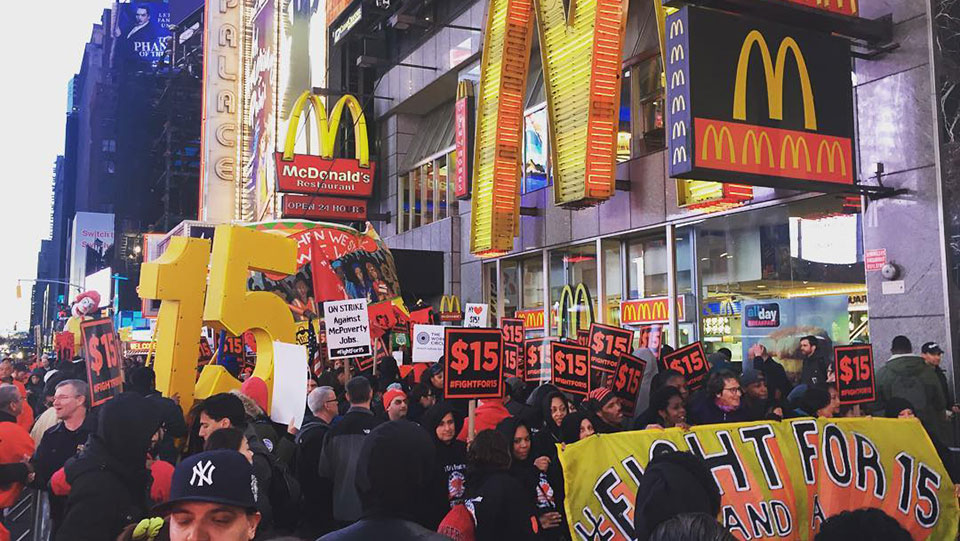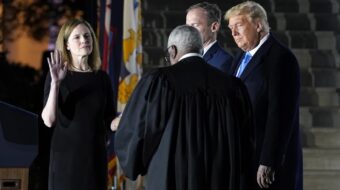
WASHINGTON—A new Trump Department of Labor (DOL) “joint employer” rule published Jan. 16, to take effect two months later, is an administration giveaway to firms that cheat their workers of minimum wages and overtime pay.
So say both the National Employment Law Project and a lawmaker who’s personally familiar with joint employers, Rep. Mark Pocan, D-Wis., a member of the Painter’s union. NELP predicts at least three million workers will suffer.
And by letting big business off the hook for wage theft, Trump’s DOL “lays the groundwork for more sweatshops,” adds NELP Executive Director Rebecca Dixon, a former top DOL wage and hour official.
DOL’s rule covers whether a company is a “joint employer” of workers under the Fair Labor Standards Act (FLSA), which governs minimum wages and overtime pay. It does not cover “joint employers” under labor law – the National Labor Relations Act — or civil rights law, DOL noted.
“Joint employers” are controversial under the NLRA, too. Several years ago, the then-majority Democratic National Labor Relations Board decided joint employers — think McDonald’s headquarters and local McDonald’s restaurants – are also jointly responsible for obeying or breaking labor law.
Trump’s GOP-run NLRB not only rolled back that ruling, but wants to write its rollback into stone by making it a federal regulation. Once promulgated, regulations are extremely hard to dislodge.
That’s what makes the DOL “joint employer” rule so damaging to workers and so encouraging of employer wage theft, Pocan and the employment law group said.
“This administration has consistently rigged the rules to allow corporations to dodge responsibility for minimum wage and overtime violations. Companies like McDonald’s should be held responsible when a worker is cheated out of their hard-earned wages,” Pocan tweeted.
NELP’s criticism of DOL was detailed. Trump’s Labor Department interprets the ‘joint employment’ standard in a way that makes it easier for corporations to cheat their workers and look the other way when workplace violations occur,” Dixon said.
“DOL’s final interpretation dramatically and improperly narrows companies’ joint responsibility for respecting fair pay and child labor laws, exposing millions of workers to wage theft.” The agency “ignored the clear language of the Fair Labor Standards Act,” U.S. Supreme Court rulings and objections from workers, states and their allies.
Indeed, buried in the text of a DOL fact sheet about its new rule is the admission that even if a firm controls a worker’s wages and working conditions, it can still get away from being a “joint employer” – and thus responsible for obeying or breaking the FLSA – case by case.
“An employee’s ‘economic dependence’ on a potential joint employer does not determine whether it is a joint employer under the FLSA,” DOL’s fact sheet says.
“An employer’s franchisor, brand and supply, or similar business model and certain contractual agreements or business practices do not make joint employer status under the FLSA more or less likely,” the fact sheet adds. Instead, DOL would decide cases one by one.
“When a company ‘calls the shots’ in a workplace, that company should be accountable for how the workers there are treated — no matter what the company calls the workers or how it classifies them,” Dixon said. “So when a company decides to contract out work to a temp or staffing firm or other labor subcontractor, it should share responsibility for the workers.”
In these days of the increasing “gig economy” and rampant subcontracting – especially by firms like Walmart and Amazon that want to get away with paying workers little and subjecting them to lousy working conditions, DOL leaves the door wide open for further abuses, she added.
“Too many employers use temp agencies and subcontractors to try to duck responsibility for wage theft. That’s why, for well over a century, the law has recognized the idea of joint employment: Companies that share control over working conditions may also share responsibility for workers’ rights.”

“This action hurts the very workers who need the law’s protection the most: The more than three million temp and staffing workers, and millions of other workers in subcontracted jobs, including those in agriculture, janitorial, construction, and warehousing. This rule will disproportionately harm Black and Latinx workers who largely comprise the workers doing these jobs, which already pay less than non-outsourced jobs in the same sector.”
Meanwhile, big businesses – such as warehousers like Amazon and retailers like Walmart – will benefit. They outsource jobs and “will more easily get off the hook for workplace violations, while the typically smaller, poorly capitalized local businesses that provide the workers will bear all the liability.”
“This leaves the small businesses, already at the mercy of terms and conditions foisted upon them by larger corporations, exposed to bankruptcy —and leaves the workers in danger of having no remedy at all.”
The Trump DOL’s gift to big business means such firms “can simply insert a temp or staffing agency into their businesses and walk away from fair pay and child labor violations, leaving smaller businesses on the hook and too often leaving employees empty-handed with no protections,” Dixon concluded.

MOST POPULAR TODAY

High Court essentially bans demonstrations, freedom of assembly in Deep South

Zionist organizations leading campaign to stop ceasefire resolutions in D.C. area

UN warns that Israel is still blocking humanitarian aid to Gaza


U.S. imperialism’s ‘ironclad’ support for Israel increases fascist danger at home






Comments